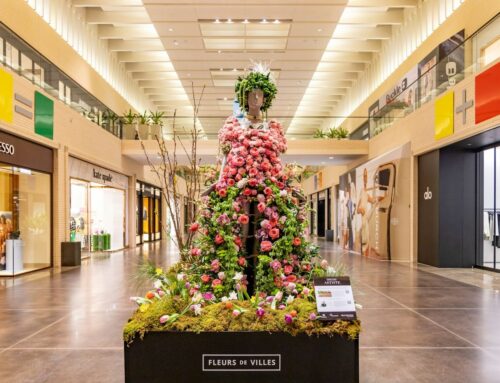Neighborhood resident Maria Luna expresses herself through crafts. In high school, this intense, unassuming blonde reveled in home economics, going beyond what was required – at one point even sewing a suit. Later, while working in construction management, Luna spiced her life by making pillows, stockings and tree skirts from vintage cloth. She avoided mall holiday crowds, wrapping her crafts as presents for friends and relatives.
Then, she became a mother and quit her job of 18 years to raise her family.
“I wanted to do something on my own, like everybody wants,” she says. “I wanted to have more flexibility in raising my children, but I still wanted to have a livelihood, a profession.”
Our neighborhood provided Luna the opportunity she needed to turn a life-long passion into a homespun business. Today, people buy her work for their loved ones.
This fall, Luna and many other neighborhood crafters have been gearing up for their busiest time of year – Christmas. They’ve made tree ornaments, wreaths, turkey platters and more, pasting, painting and hammering in hopes that someone will want to take a little piece of themselves home for the holidays.
Our neighborhood draws and nurtures creative people, says Luna, who calls herself a three-dimensional artist.
“People here give themselves more time for their families and their passions,” she says.
Rebecca and Jason Barnes, who live near Luna, say they received a lot of free advice from neighborhood crafters when they began selling their metal artwork.
Creative people move to our neighborhood because the houses and landscaping are not “cookie cutter” like the suburbs, Rebecca says.
“There is individual style,” Jason says, “and that attracts people.”
Ceramist Nancy Gienger, who participates in the same preschool PTA as the Barnes and Luna, says “there is kind of an underground network” of crafters that helps newcomers.
These crafters have found that our neighborhood offers many opportunities to market their wares. Local art festivals, fund-raisers, auctions, raffles, church and community bazaars, and the Lakewood Craft Mall provide ways to publicize creative work, they say, which is important when most business is generated through word-of-mouth.
THE ART OF MARKETING
Luna started in the crafting business just a few miles from her Hollywood/Santa Monica home. With an armload of pillows and table runners, she went to the Lakewood Craft Mall, 1908 Abrams Parkway, and leased a tiny wall space for display.
The six-year-old mall sells the work of more than 200 crafters, says Geralyn Wooten, who runs the mall with her mother and sister. All three are crafters.
At the mall, crafters sell their merchandise from leased space – display prices range from $27 monthly for a shelf to $177 monthly for a closet-size booth. The mall also takes a five percent commission, which covers credit card and check cashing fees and security, Wooten says.
Most neighborhood homeowners look for collectibles, and many dress their homes for the holidays, Wooten says.
The mall is her primary “marketing tool,” Luna says.
“When people can see and touch, it’s better than flat advertising,” Luna says. “Part of the problem is getting your product out. That’s why a craft mall is good. They provide the man hours to watch it, take care of it, sell it and take in the checks.”
Luna’s mall booth has grown, and she now has a window display. Her initial investment was about $300 in materials, she says.
“I think a whole lot of people think you have to have a lot of money, and you don’t,” she says. “Keep your inventory down and keep it simple.”
In addition to sewing, Luna specializes in floral wreaths. As an organic gardener, she dries most of her flowers. She says some crafters also browse flea markets for inexpensive treasures.
Luna prices her basic work in the $20-$40 range and increases the cost based on the item’s detail, she says. She works two days a week on crafts, spending the rest of her time caring for her 1-year-old and 4-year-old.
She also designs window treatments and is a home-decorating consultant, which is how she makes most of her money. Luna says she makes between $20,000 and $30,000 a year. People who solely make crafts can expect to earn between $10,000 and $15,000 if they actively market their work, she says.
Between September and the end of the year, serious crafters attend bazaars every weekend, she says, but in the off-season, these opportunities are infrequent. A good bazaar nets $500 to $700, she says.
Once both her children are in kindergarten, Luna plans to craft full-time, she says. Her husband, Patrick, works as an engineer, but he also is pursuing his passion: black and white photography. They juggle family, work and play – while still trying to find creative outlets.
“It’s a balancing act,” Luna says. “Everyone has to do it.”
BABY STEPS
The Barnes know the balancing act all too well.
With a baby due in January and a two-year-old tearing through their house, the Barnes says they aren’t ready to take the financial risk of turning crafting into a full-time career.
During the day, Jason works as a graphic artist while Rebecca, a former architect, stays home with their daughter and draws designs for their crafts, made mostly of copper and steel.
At night, Jason works in their backyard shed, hammering metal scraps into water fountains, bird baths, picture frames, vases, clocks, candle holders and almost any other household item imaginable.
For the holidays, they make Christmas tree ornaments. This year, they also plan to create crosses, snowflakes and stars for hanging in windows and on walls.
They find much of their material in salvage yards and also buy copper sheets from a Deep Ellum metal supplier. Copper is costly, Jason says, and most profit is reinvested in new machinery and more materials. The Barnes have gone from an initial investment of $50 in equipment to thousands of dollars, Jason says.
But the business is growing steadily, Rebecca says. The business wouldn’t survive on bazaars alone, so the Barnes attend art festivals and hope to exhibit their work in art galleries. They sell pieces in furnishing stores and also do custom work. Their larger items sell for $125 for the average bird bath to the $500 they once charged for a large steel fountain, Jason says. Smaller items are less expensive, such as $3 ornaments or $10 to $30 picture frames.
The Barnes recently received their largest order from a Neiman Marcus executive who commissioned 11 pieces, including a door bell, for his new Florida home.
But the ball started rolling in Lakewood.
The Barnes’ first public appearance was at the 1995 Lakewood Home Tour, an annual fund-raising event for Lakewood Elementary, which includes a craft fair at the school.
Initially, they only wanted a bird bath for their yard, “something contemporary,” Rebecca says. But the baths for sale were too expensive, she says, so Jason decided he’d try his hand at making one.
“We made the bird bath and received some compliments,” Jason says. “So, I made some for my family as gifts. Then, someone wanted to buy one. We decided, shoot, why don’t we try this.
“It seems like a way for me to spend more time at home – eventually.”
NOT PICASSO, BUT…
Nancy Gienger, a mother of three, has taken art classes since childhood and has painted everything from tennis shoes to toilet plungers. Crafting allows her to be a homemaker, an artist and a businesswoman, she says.
Gienger is primarily a ceramic artist, making Christmas pins and tree ornaments, platters and other dishes, and children’s tea sets. She also paints furniture and murals and uses a scroll saw in her garage to carve wooden key holders, customized to look like people’s houses. She buys most of her materials at MJ Designs, she says.
She hadn’t thought about making money with her art until a neighbor encouraged her several years ago. The neighbor bought a supply of Gienger’s Christmas ornaments as office gifts.
From here, Gienger decided to go to a fall craft show in Forest Hills and was surprised when her items sold out, she says.
“I started taking art lessons at age 5, but I sort of burned out in high school,” she says. “The teachers made me feel like if I wasn’t Picasso, I shouldn’t bother.
“I think they did me a disservice. There’s a lot of levels in art. That is what’s great about the craft movement. It’s a good outlet for people.”
Gienger says she couldn’t make a living with her crafts, but that’s not her goal. Her husband brings in enough income as a mechanical engineer.
Gienger sells her ornaments for $12 to $16. Her platters average $45, and her tea sets average $35. She says a good bazaar for her nets $1,000 to $1,500. But Gienger doesn’t attend many bazaars. She mostly works to order, but says bazaars are good for generating interest and future clients.
Despite her growing business, Gienger says she would craft whether she was paid or not.
“I can’t help doing it,” she says. “It’s very relaxing. I’m going to do it even if no one ever buys anything because I did it before anyone bought anything.”
Gienger plans to expand into other art mediums. She grows bored if she doesn’t experiment with new things, she says. Our neighborhood is supportive of her artistic pursuits and provides a stable customer base, she says.
“The people here are a little more eclectic,” she says. “They have a real gung-ho spirit. They aren’t afraid to try something.”





